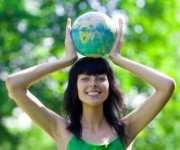 All together now!Photo: Edu van GelderCross-posted from RH Reality Check.
All together now!Photo: Edu van GelderCross-posted from RH Reality Check.
Two experts — Dr. Carmen Barroso, director of International Planned Parenthood Federation (IPPF), Western Hemisphere Region, and Carl Pope, former executive director and current chair of the Sierra Club — explain the connections between environmental and population issues and how the movements can work together.
Q. When did you start to see the synergy between environmental and population issues?
A. Carmen Barroso: I remember when we didn’t see them. In the 1980s, I was living on the outskirts of Sao Paulo, Brazil, developing a sex-education program with local women’s organizations. True to our feminist lineage, we were advocating for women’s right to decide in matters relating to sex and reproduction. Working in the context of Brazil’s left movement, our sex education also included a critique of population control, which was a prevalent symbol of imperialism at the time.
Our concern was both with coercive practices, such as sterilization without consent, and with the notion that population stabilization could somehow be interchangeable with a fair global economy, the “new economic order,” as it was called then. At that time, there was considerable tension between social justice–oriented feminists and environmentalists who championed population control.
Today, more than 30 years later, environmentalists and reproductive-rights movements share a lot more commonalities, rather than differences, in our approach and commitment to justice and autonomy. In fact, IPPF’s governing council recently adopted a policy on climate change and sustainable development. We know that population growth is just one of the several drivers of environmental problems, but we can’t ignore its connection.
Carl Pope: In the late 1960s, I was working to advance family-planning methods in small villages in Bihar, India, as a Peace Corps employee. I was struck by the fact that so much of the challenge of enabling villagers to make decisions about family size had to do not with their “ignorance” or “lack of interest” as often described by government bureaucrats, but with the indifference of that bureaucracy and the lack of genuine access to either education or health care.
Informed by that experience, Sierra Club’s Global Population and Environment Program works to increase access to voluntary family-planning services, as part of a larger framework of access to education and health care, and a broader and more inclusive role for women. The Club, however, realizes that population size is just one piece of the population/environment puzzle. The way we consume and use natural resources and the underlying social inequities of resource distribution and consumption are the other side of that coin. We believe we can be mindful of our global environment while simultaneously improving the lives of men, women, and children worldwide.
Q. Why do you think a comprehensive, rights-based approach is the way to go?
A. CB: Laurie [Mazur] said it best in her opening post for this series: Ensuring women’s rights, especially reproductive rights, is central to meeting the flock of “Black Swans” that are headed our way. When you empower individuals and families with the information and services they need to decide on all aspects related to reproduction and sexuality, you fundamentally create more sustainable and just communities.
Over the last few decades, notions about the relationship between population, sustainability, and human rights have advanced significantly. At the center of this evolution was the International Conference on Population and Development, held in Cairo in 1994. In Cairo, 179 governments placed human rights, specifically sexual and reproductive rights, at the center of population policies.
While governments have been slow to implement the Cairo consensus, this vision must guide development efforts going forward. That means securing reproductive health and rights for the millions worldwide who lack access, so that they can choose if, when, and how many children to have.
CP: Empowering individuals, particularly women who are most vulnerable, is a proven silver bullet in addressing the “Black Swans.” Once education and outside employment for women become available and even accepted as pathways out of poverty, families face a choice: Have a smaller family and treat each child as a long-term investment by educating them, or have a larger family and run the risk that each child will get less schooling and have fewer economic prospects.
In addition, women who bring in income have more say in family decision-making, and they opt for still smaller families. All over the globe women are choosing to have fewer children.
Therefore, it is our global responsibility to secure access to voluntary family-planning services for all as a means of advancing both reproductive choice and sustainable development.
Q. Why do you think environmental issues have not been high on the agenda of reproductive-rights advocates and vice versa?
A. CB: As I said earlier, just a few decades ago economic justice and individual rights seemed incompatible, and the two movements were at odds. It’s funny — when I was working with women’s groups in Sao Paulo, we tried out a cartoon depicting two women. One of them said: Did you see the TV last night? They said we are poor because we have too many children. The other responded: That is nonsense. They should distribute income instead of the pill.
In today’s interconnected world, however, there is no denying the intersection of environmental and health and rights issues. Still, collaboration remains a challenge. On the one hand, the reproductive-rights movement fears being co-opted by the small faction of the environmental movement that would advocate for the curtailment of individual rights if it benefited the environment. On the other hand, I think some in the environmental movement fear being associated with reproductive rights, which remain contentious is some political arenas. And, as always, the silo-ed approach to funding and the competition it creates is also an obstacle to working together.
CP: I agree that we sometimes let the fear of the small factions among us who don’t want to work together silence the critical masses that agree on our issues. If the reproductive-rights movement and the environmental movement could work together, both movements would gain leverage in their ability to reach out into new arenas. The strength of two is double the strength of one, so to speak.
As the nation’s largest grassroots environmental organization, the Sierra Club supports the highest levels of funding for voluntary family-planning services both in the United States and worldwide, a comprehensive approach to sex education, and sustainable-development policy initiatives. We also work aggressively to end unsustainable practices such as defores
tation and fossil-fuel use because we recognize that addressing environmental degradation includes curbing rampant consumption.

Read more on population. Check out our series 7 Billion: What to expect when you're expanding
A. CB: From my perspective, the most important things the two movements can do are to listen and learn from each other. There is power in numbers, and I have no doubt that both movements would achieve more victories through collaboration.
The other opportunity I see is the fact that today’s generation of youth — the largest ever — seems to approach advocacy differently. They are less influenced by the silos or labels like feminist, gay-rights activist, environmentalist. The bottom line for this new generation is justice and rights for all. They want better income distribution, an end to climate change, AND the pill.
CP: Exactly. Our planet will be home to 7 billion people this year, with 50 percent of those people being under 25. The youth are demanding access to family planning, education, health care, and economic opportunities for all, as well as an end to climate change, and a sustainable, just world.
We as a united movement should view the demands of the youth as the watchwords for our advocacy.




